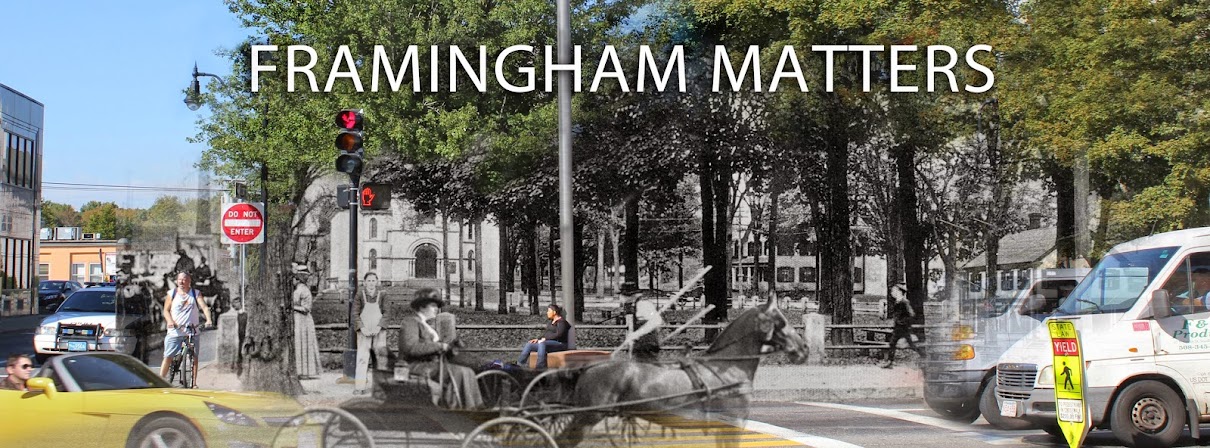Framingham is a community of over 68,000 people inhabiting an area of 25 square miles and possessing a diversity of neighborhoods and people.
Most of us are familiar with the lovely neighborhood of the Framingham Centre Village Green which is bordered by the Village Hall, the History Center and colonial churches. We look forward to the Farmer’s Market and the Concerts on the Common.
On the southeast corner of Framingham is an area about twice this size. It is bounded by Beaver Street, Leland Street and Irving Street. Within this densely populated area are three known toxic chemical sites. This is an Environmental Justice Neighborhood.
For over 100 years (late 1880s to 1960s) companies like Dennison Corporation, Old Colony Tar Company and Com Gas located factories there because the area possessed railroads, waterways and a ready population of workers. These businesses brought jobs and prosperity to Framingham. Their owners sat on our Town Boards and donated civic buildings. However they also polluted our land and waterways with carcinogenic toxins such as coal tar, coal tar creosote, lead, chromium, arsenic and cyanide.
The U.S. EPA defines Environmental Justice as “the fair treatment and meaningful involvement of all people regardless of race, color, sex, national origin, or income with respect to the development, implementation and enforcement of environmental laws, regulation and policies.”
Pages
Thursday, November 16, 2017
Tuesday, November 7, 2017
The (Harvard) College Lands identified in 1699 map
(draft)
The College Lands
Excerpts from "History of Framingham 1640-1880" by J.H. Temple
(Read from book: https://archive.org/stream/historyofframing00temp#page/n3/mode/2up
(p.104-105)
In a codicil to his will, Mr. Danforth, under the heading "Deeds of gift," specifies: "To the College three tenements on lease to Benjamin Whitney, John Whitney, Isaac Bowen, situate at Framingham, on such conditions as I shall name." These three tenements were the sixty acres granted to Richard Wayte, and purchased of him by Mr. Danforth, lying northeast of Waushakum pond, and extending to the Beaver dam. This tract was leased by Mr. Danforth to the parties above named, who built three houses near each other, on the road northeast from the pond. The Sturtevant house occupies the place of Benj. Whitney's, which was the middle one of the three. After Mr. Danforth's decease the lessees paid the rents to Harvard College. Mr. Bowen sold his lease to Moses Haven, who (or his sons) bought out the Whitneys. Prof. Pierce, in his History of Harvard College, states that the College sold its Framing- ham lands to Mr. Haven for ;!^ioo in 1764. But in the valuation of 1771, Dea. Moses Haven is taxed ^3 on College land; and in 1772 the town voted that the constable be directed not to distrain those persons that occupy College land for their Province tax levied on said lands, till further orders from the town. This vote was reversed at the May meeting same year.
The College Lands
Excerpts from "History of Framingham 1640-1880" by J.H. Temple
(Read from book: https://archive.org/stream/historyofframing00temp#page/n3/mode/2up
(p.104-105)
In a codicil to his will, Mr. Danforth, under the heading "Deeds of gift," specifies: "To the College three tenements on lease to Benjamin Whitney, John Whitney, Isaac Bowen, situate at Framingham, on such conditions as I shall name." These three tenements were the sixty acres granted to Richard Wayte, and purchased of him by Mr. Danforth, lying northeast of Waushakum pond, and extending to the Beaver dam. This tract was leased by Mr. Danforth to the parties above named, who built three houses near each other, on the road northeast from the pond. The Sturtevant house occupies the place of Benj. Whitney's, which was the middle one of the three. After Mr. Danforth's decease the lessees paid the rents to Harvard College. Mr. Bowen sold his lease to Moses Haven, who (or his sons) bought out the Whitneys. Prof. Pierce, in his History of Harvard College, states that the College sold its Framing- ham lands to Mr. Haven for ;!^ioo in 1764. But in the valuation of 1771, Dea. Moses Haven is taxed ^3 on College land; and in 1772 the town voted that the constable be directed not to distrain those persons that occupy College land for their Province tax levied on said lands, till further orders from the town. This vote was reversed at the May meeting same year.
 |
| Overlay of College Lands and present streets |
Monday, November 6, 2017
Skatepark construction underway
 |
| Final selected site for skatepark |
 |
| October 2, 2017 |
 |
| October 2, 2017 |
 |
| October 2, 2017 |
 |
| October 2, 2017 |
 |
| October 26, 2017 |
 |
| October 26, 2017 |
 |
| October 26, 2017 |
 |
| November 3, 2017 |
 |
| November 3, 2017 |
Subscribe to:
Posts (Atom)

